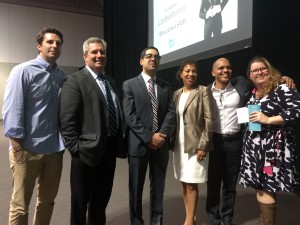
Now that we’re settling into the first quarter of 2016, we are setting our sights on identifying industry trends to determine client priorities for the year ahead. In working with our growing roster of higher education clients, our team has noticed a shift in the education landscape towards revitalization and streamlining strategies to accommodate the changing needs of stakeholders. Through our research and interactions with clients, we’ve compiled a list of trends that we believe will be part of the higher education space going forward in 2016.
- Revisiting Recruitment Strategies
Marketing Mix: It’s no secret that today’s students are immersed in a digital lifestyle. That has led many institutions to investigate or implement digital strategies aimed at attracting and retaining top-notch students. Ruffalo Noel Levitz conducted a poll in 2015 to determine the communication preferences of high school students and parents with institutions. Interestingly, they noticed a preferential shift towards direct mail by college students compared to 2011. This finding led them to conclude that institutions should develop and deploy a mix of recruitment strategies – digital and print. Noel Levitz suggests that students may prefer to receive college information via direct mail, but they are unlikely to respond through the same medium. Instead, the goal should be to entice the prospective student to visit the college website for further information. It will be important for institutions to examine their current suite of marketing strategies to ensure they align with the expectations of their target student audience.
Adult Learners: Where we’ve seen the most interest from our higher education clients in 2015 is in identifying how best to reach the adult learner population within their geographical recruitment footprint. High school graduates are no longer the staple for all institutions. Instead, they’re expanding their portfolio to include non-traditional and adult learners to capture those interested in beginning their college career at a later age, or advancing a skill set. Continuing education and personal enrichment courses are of particular interest for community colleges, where prospective learners are already accustomed to a more flexible atmosphere including part-time study and evening course options. Institutions are exploring the preferences of this growing segment of the population, and investing in curriculum that will meet their needs.
International Student Recruitment: There has been a lot of buzz over the last couple years about a spike in international student recruitment. Given that it’s become the norm for most colleges to be operating under financial burdens, it’s no surprise that that they would invest in targeted recruitment of individuals who bring more revenue to the institution. The uptick in international student recruitment has led to more benefits than simple financial gain for many colleges. A 2015 report produced by The Lawlor Group notes that international students also boost cultural campus diversity, while also bringing a more personal “global perspective” into the classroom. In their 2015 report, Hanover Research points out that institutions are now turning to specialized companies such as Pearson, which offers a “Progression+” college informational service, to assist in the targeted recruitment of international students. While the concept is intriguing, it’s certainly not appropriate for all institutions. It is essential to consider whether an increase in international student recruitment is appropriate for your college. To attract top-quality students, institutions now need to offer desirable financial aid packages (which was not the standard even a few years ago), invest in a digital presence, and attend appropriate higher education conferences (some of which require travel abroad).
- Competition from Alternative Education Programs
Alternative learning methods such as MOOCs have been in effect for many years, although opinion varies on their effectiveness and impact on traditional bricks-and-mortar higher education institutions. Newer alternative learning entrants to the market include mini bootcamp and nanodegree style learning opportunities. With the technology boom still in full swing, these alternative education methods are becoming increasingly popular and available. Many careers in technology are listed as high-need, high-wage, and high-skill, but there is a lack of qualified individuals in the workforce to fill the needs of employers, making these options attractive to both employers and individuals looking to break into a booming workforce or improve their competitive stance in the marketplace. These programs offer students the benefit of flexibility (often fully online at their own pace), they can be completed in shorter time frames than a traditional college education, and are often much more affordable. A great example is Udacity’s availability of several nanodegree programs which can be completed in about a year and cost $200 per month, with a promise to get half your tuition back if you complete the program in 12 months or less. The emergence of these options is certainly something that higher education administration is already keeping a close eye on. Over the last year, RMS has also seen a growing interest in higher education feasibility studies regarding online program options. Institutions are realizing that to stay competitive, they may need to refresh their current suite of academic offerings to better align with the evolving needs of the education consumer.
- Competency-Based Education
The streamlined approach to higher education has taken further shape in recent years through the growth in competency-based education (CBE) programs. CBE programs measure a student’s progress based on how well they learn the material rather than the length of time to complete a degree. In a traditional program, a student typically must complete a minimum number of academic credits, regardless of how well they already know the material. CBE programs allow students to learn at their own pace, and demonstrate via learning mastery. A research brief published by Public Agenda in late 2015 revealed the results of the largest survey effort on the topic of CBE programs, including baseline CBE adoption data by participating institutions, program design and implementation data, opportunities, and barriers experienced by respondent institutions. The brief disclosed that nearly 600 institutions offer CBE programs, with public institutions leading the way. Bachelor’s and Master’s degrees are the most popular credentials earned by graduates of CBE programs at institutions who have a fully active program(s) or are scaling up CBE efforts. However, the majority (64%) of responding institutions are in the planning phase of CBE adoption while only 14% have implemented a CBE program. It’s clear that administrators view CBE programs as the future and it will be interesting to see if the concept evolves to become the norm in higher education learning.
- Automating Marketing Efforts
With the continual expansion of digital channels available, higher education institutions have to balance a multitude of marketing efforts to reach their target audiences. Many institutions have to balance social media marketing, email, a website, and content marketing while finding a way to integrate all of the data that allows them to gain meaningful insights which shed light on how best to connect with current students, prospective students, alumni, and other stakeholders. This has led to an increase in the popularity of marketing automation solutions. Marketing automation tools synthesize an institution’s marketing efforts to allow for in-depth marketing campaign analysis, tracking of campaign analytics and ROI calculations, among a myriad of other efforts. Institutions that use these automation tools have the ability to enact more personalized communication efforts, which is thought to resonate well with both traditional and non-traditional students by making them feel connected to their campus. Since marketing automation is still yet to be standard on college campuses, adoption of these tools would provide an institution with a competitive edge.
This is the first in our series of higher education trends, so stay tuned for updated trends throughout the year! Research & Marketing Strategies (RMS) is a market research firm located in Syracuse, NY. If you are interested in learning more about our higher education market research services, please contact the Senior Director of Business Development & Corporate Strategy, Sandy Baker at SandyB@RMSresults.com or by calling 1-866-567-5422.
Sources:
“2015 High School Students’ and Parents’ Perceptions of and Preferences for Communication with Colleges.” Ruffalo Noel Levitz, 2015. https://www.ruffalonl.com/documents/gated/Papers_and_Research/2015/2015_Perceptions_Preferences_Report.pdf?code=3913351183201512
“A Research Brief on the Survey of the Shared Design Elements & Emerging Practices of Competency-Based Education Programs.” Public Agenda, December 2015. http://www.publicagenda.org/files/SurveyOfSharedDesignElementsAndEmergingPracticesOfCBEPrograms_PublicAgenda_2015.pdf
“2016 Trends in Higher Education Marketing, Enrollment, and Technology.” Hanover Research, November 2015.
Buege, V. “International Recruitment: Today’s Issues and Opportunities.” The Lawlor Group, April 2015. http://www.thelawlorgroup.com/international-recruitment-todays-issues-and-opportunities/
Duncan, Scott. “Marketing Technology Adoption in Higher Ed: From CRM to Marketing Automation.” Higher Education Marketing, November 5, 2014. http://www.higher-education-marketing.com/blog/education-marketing-blog/marketing-technology-higher-ed-crm-marketing-automation
Mathewson, Tara G. “5 Higher Ed Trends to Watch in 2016.” Education Dive, December 30, 2015. http://www.educationdive.com/news/5-higher-ed-trends-to-watch-in-2016/411362/
Read Full Post »









